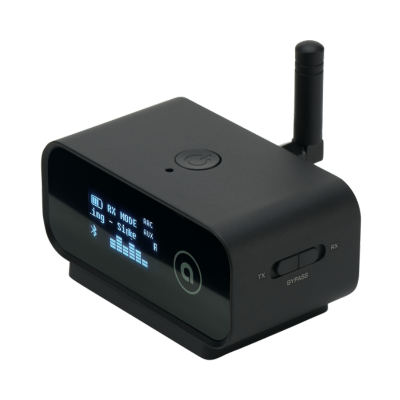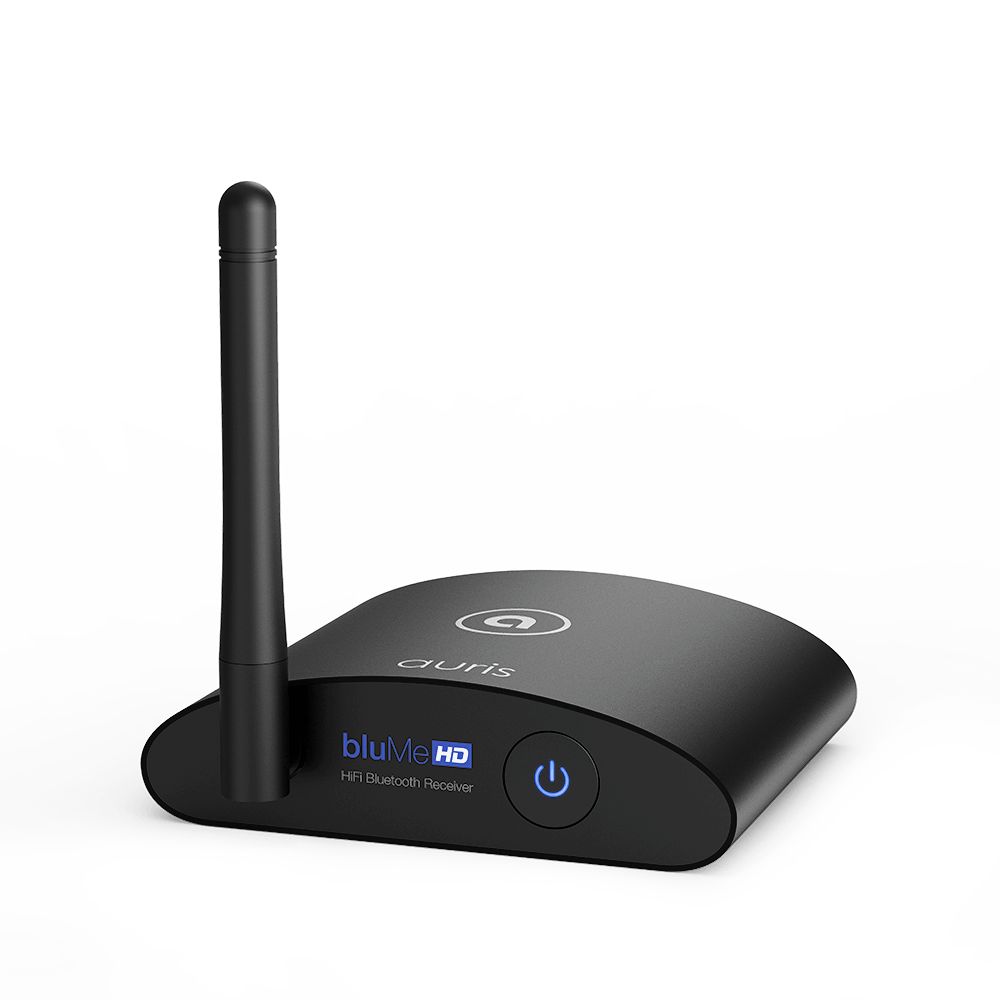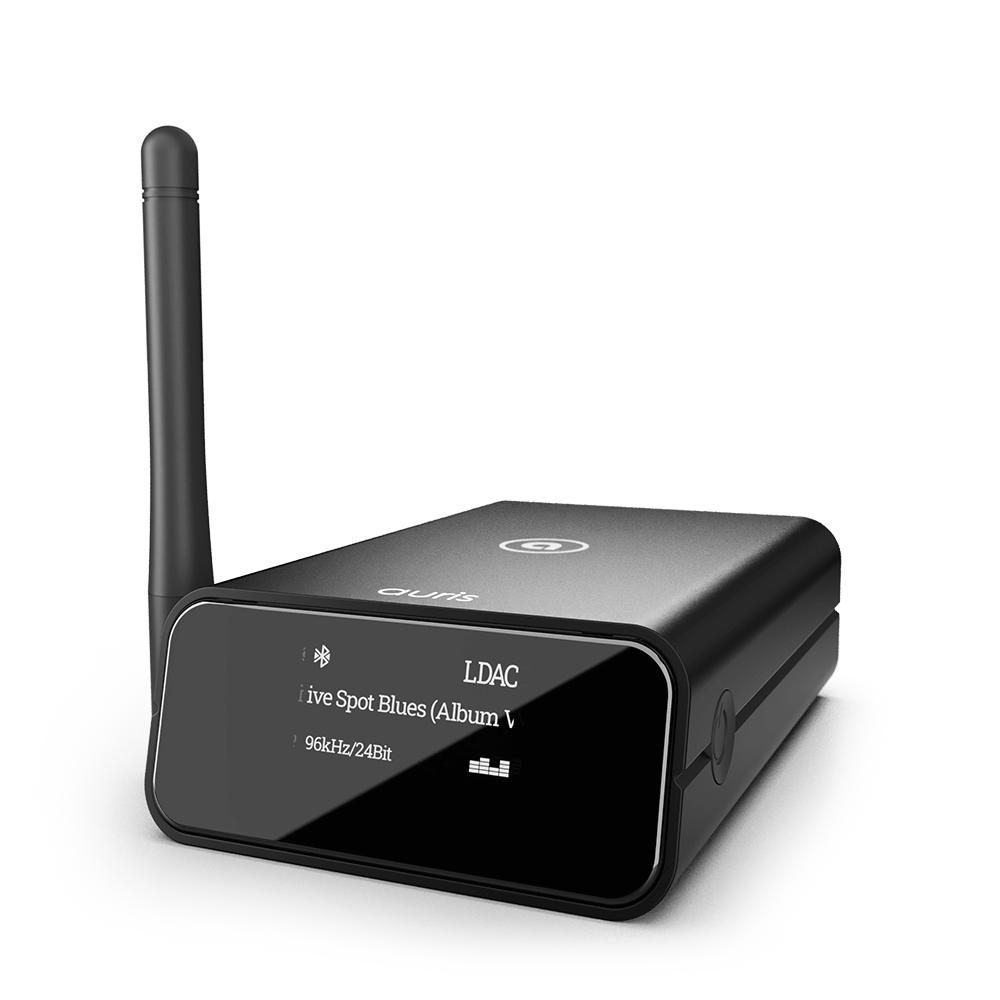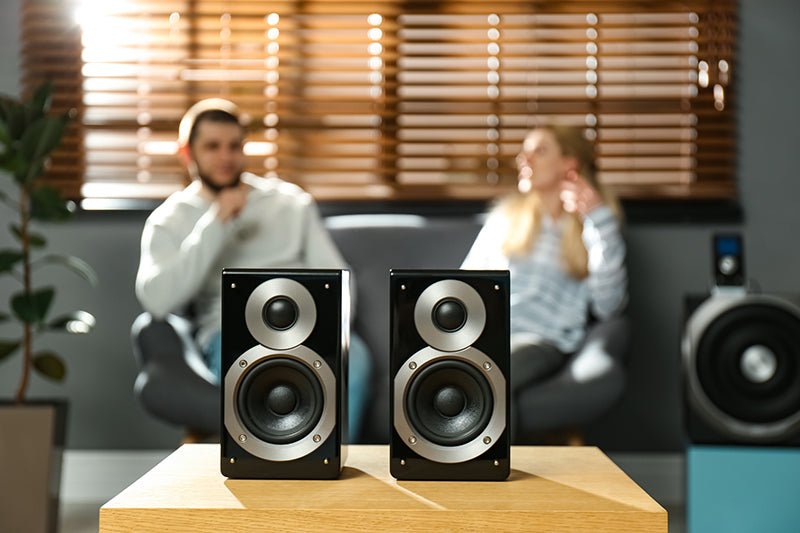
About 20 years ago, wireless technology didn’t exist. People relied on technology like landline phones and dial-up internet for daily communication. But slowly, as time went on, wireless technology like Bluetooth became a part of our everyday routines.
You probably use Bluetooth technology constantly and never even think about how it works. Your phone, earbuds, laptops, and cars use Bluetooth to provide you with a seamless listening experience.
However, there are still devices we use that aren’t capable of being wireless. Bluetooth Audio transmitters can help transform these devices and bring them into the 21st century.
Table Of Contents
- What Is A Bluetooth Audio Transmitter?
- How Do You Use A Bluetooth Audio Transmitter?
- Bluetooth Receiver Vs. Bluetooth Transmitter
- How To Find The Right Bluetooth Transmitter For You
- Different Ways To Use A Bluetooth Audio Transmitter
- Do Transmitters Interfere With Other Devices Over Bluetooth?
- Analog Vs. Digital
- Is A Bluetooth Transmitter Or Receiver Better?
What Is A Bluetooth Audio Transmitter?

A Bluetooth audio transmitter enables TVs, audio systems, and other non-Bluetooth devices to stream high-quality sound to Bluetooth headphones, earbuds, or speakers. The transmitter sends a Bluetooth signal out that connects to a compatible device.
The transmitter decodes information into a transferable format and then sends that information through radio waves to a receiver. The transmitter produces the audio frequency itself, which is picked up by a receiver.
Let’s dive a little deeper into how Bluetooth really works.
Background On Bluetooth Tech
Bluetooth was designed to replace RS-232 telecommunication cables. It wasn’t originally intended for streaming audio, but that is mainly how it’s used today. Bluetooth was invented in the 1990s and has come a long way in the past 30 years.
Bluetooth technology uses radio frequency topology, which is referred to as “star topology.” A group of devices synced this way is called a piconet. This piconet contains the master device and up to seven other devices in the network.
In simpler terms, Bluetooth tech utilizes the ideas of “inquiry” and “inquiry scanning.”Then, scanning devices will “listen in” on the network for devices that are actively inquiring. Bluetooth signals can go through walls, but certain obstacles can affect the strength of the signal.
What Interferes With Bluetooth Signals?
While Bluetooth technology has advanced significantly since the 1990s, some factors can still interfere with its signals. Common examples include:
- Other wireless devices in the area, such as Wi-Fi routers or other Bluetooth devices
- Physical barriers such as metal, plaster, concrete, and bulletproof glass
- Electrical wires in the wall that aren’t shielded
- Microwave ovens
If you notice signal degradation, check the nearby area and see if anything could be causing the problem. You may need to move your Bluetooth audio transmitter to ensure a solid connection. Otherwise, you risk losing sound quality or even getting disconnected.
Do I Need A Bluetooth Audio Transmitter?
Now that you know more about how this Bluetooth technology works, you may wonder if you need it. The answer depends on your audio setup and personal preferences.
If every part of your audio setup already has built-in Bluetooth capabilities, you most likely won’t need a separate transmitter. However, you might want a transmitter if you’re using devices without built-in Bluetooth.
How Do You Use A Bluetooth Audio Transmitter?

For a Bluetooth audio transmitter to work, it needs to connect to a device’s digital or analog output by sending a signal to a Bluetooth-capable device.
Make sure that both of your devices are relatively close to one another. You’ll probably have to turn the transmitter on and put it into pairing mode. Since this process is different on each device, you’ll want to check your owner’s manual for the directions.
You may need to:
- Go to your Bluetooth settings
- Push a button to enable discovery mode
- Select the right device from a list of options
Now, the Bluetooth-receiving device should be able to pair with the transmitter, and you’ll have a connection.
Most Bluetooth transmitters can remember previous devices they’ve been paired with. They store them in a list, each device having a unique name. This makes it easier to connect the next time.
You simply click on the right device’s name, and as long as it's in range and turned on, you shouldn’t have any trouble connecting. If you don’t like the name your system automatically assigned, you can change the device’s name.
However, another device cannot pair with the transmitter if it’s trying to connect to yours. So if you’re trying to share one Bluetooth audio transmitter between two people with different devices, you’ll each need to disconnect after use. Otherwise, the next person will have trouble.
Also, if you’ve paired with a Bluetooth device that you no longer want to connect to again, you can usually clear the pairing history by reading the instructions that came with your transmitter.
Sometimes, you may need to “forget” the device. In other instances, you can delete it by clicking a trash can symbol. Once you’ve done this, you’ll need to pair it again if you decide to use it later.
Note: If you’re having trouble pairing your device, read this post: How to Fix Bluetooth Pairing Problems.
Bluetooth Receiver Vs. Bluetooth Transmitter

When shopping for Bluetooth devices, you may have noticed receivers and transmitters. But what are the differences between these two, and which should you buy?
Both of these devices make it easier to listen to your favorite audio, but they work differently. It’s crucial to understand the difference between them so you can get the right one for your needs.
Bluetooth Transmitter
As we mentioned, a Bluetooth transmitter lets you use non-Bluetooth devices to stream high-definition sound to Bluetooth speakers and headphones.
Bluetooth Receiver
On the other hand, a Bluetooth receiver works in reverse compared to a transmitter.
A receiver attaches to analog or digital stereo systems and allows you to listen from your phone to the speaker. It takes in a Bluetooth signal to stream audio from a non-compatible device, such as a wired speaker.
You can also answer phone calls using this device and play the audio through your speakers or a headset.
Can You Find A Bluetooth Audio Transmitter That Also Receives?
The answer is yes, you can! Auris offers a Wireless Bluetooth Audio Transmitter and Receiver device. It allows you to enjoy high-quality wireless audio streaming from your existing TVs and home theater systems to your Bluetooth headphones or speakers.
The receiver function allows audio streaming from any Bluetooth-enabled smartphone, and it supports Qualcomm aptX Low Latency technology. This eliminates lip-syncing issues and lets you enjoy lag-free audio. It streams real-time audio to up to two Bluetooth headphones or speakers simultaneously.
Our transmitter and receiver all-in-one has a sleek and compact design with gel mounts that you can install on your TV and audio equipment. It features analog and digital inputs and outputs for compatibility with old and new audio devices and TVs alike.
How To Find The Right Bluetooth Transmitter For You

There are many Bluetooth transmitters on the market. A lot of them are similar in design and functionality, with a few key differences.
Here are some of the things to look for if you’re in the market for a Bluetooth audio transmitter.
Easy Connection
Look for a device that’s easy to connect to. It can be tricky when transmitters require an app to download first or have a wireless router network requirement. You want a Bluetooth transmitter that will stay connected without repeated failures.
Latency
Latency is a big factor to consider when it comes to Bluetooth transmitters. Look for a device that supports aptX and aptX Low Latency. This will ensure that your audio delivers sound that is in sync with what’s on your screen.
Playback Quality
The sound output shouldn’t be reduced because of a Bluetooth transmitter. Find a device with audiophile-grade playback quality.
Here are some words to look for when comparing models:
- Lossless audio streaming
- High-quality audio codecs
- Distortion-free sound
Multi-Device Pairing
Multi-device pairing is another huge consideration for Bluetooth transmitters/receivers. If you’re looking to use two devices with your transmitter, make sure it has this functionality. Otherwise, you’ll constantly have to pair and unpair to ensure the right device is connected.
Portability
Size matters, especially if you plan on using your Bluetooth transmitter while traveling. Look for a compact device that’s easy to pack and carry around without taking up too much space.
Connectors
What devices do you plan on using your Bluetooth transmitter with? Take note of the type of connectors you’ll need, and ensure they’re compatible with the transmitter you’re considering. You may need to purchase a special dongle to make everything work together.
Range
The range of your Bluetooth audio transmitter is very important, especially if you plan on using it in a large space or outdoors. Look for devices that have a range of at least 30 feet.
For example, the blueMe Pro from Auris has a high-gain antenna for long-range streaming up to 30m/100ft. You won’t have to worry about trying to stay right next to your transmitter with this one.
Different Ways To Use A Bluetooth Audio Transmitter

There are multiple ways you can use a Bluetooth audio transmitter in your home or on the go. For example, you can use one with your television, car radio, or computer. Let’s look at each of these more closely.
Television
The first use case is connecting your television to your wireless headphones or speaker. Some newer TVs have built-in Bluetooth capabilities, but most old ones do not. If yours doesn’t, that’s OK. You just need an audio transmitter.
Simply connect your transmitter to the TV’s audio output. Pair the Bluetooth-enabled device with the transmitter, and you’re ready to go!
Car Stereo
Remember when CD changers were all the rage? They took up so much space but let you play many different songs without physically switching discs.
Now, most cars don’t even have CD players at all. Times changed, and these days, we stream music through our phones.
But what if your car doesn’t have Bluetooth capabilities? Are you stuck using a cord to tether your phone to the stereo? Or trying to find all the new tunes on CD? Thankfully, the answer is no!
You can use a transmitter for your car to connect your car’s audio system to your phone.
You’ll need to find a Bluetooth FM transmitter that’s compatible with your car. Most go into the auxiliary power outlet or cigarette lighter.
Once plugged in, you’ll need to find an empty FM channel to tune in to and select the same channel on your transmitter. The channel that works for you will depend on what signals are already in your area.
When you find an empty channel, it helps to save it to one of your car stereo’s favorite slots to make it easy to find again. Once everything is connected, you can turn on a playlist from your phone and stream your favorite tunes as you drive.
Headphones
Lastly, a Bluetooth transmitter can be used to connect your PC to wireless headphones. Plug your transmitter into your PC and install it. Next, pair your device with the transmitter, and you can listen to music or watch your favorite show wirelessly.
Just make sure you stay within range, or you’ll find your audio cutting out.
Do Transmitters Interfere With Other Devices Over Bluetooth?

One of the issues with certain transmitters is that they can cross signals with other Bluetooth devices and lose their signal. As we mentioned earlier, Wi-Fi interferes with Bluetooth in some cases.
Make sure that you get a transmitter with high interference tolerance. This will allow you to have a much more stable signal in areas with a lot of interference over Bluetooth.
Analog Vs. Digital
Devices that aren’t Bluetooth-capable likely fall into one of two categories: analog or digital.
Analog devices transmit sound through a continuous analog signal and produce high-fidelity sound. These devices play back exactly what was recorded when you listen to them.
Digital devices use binary codes to deliver sound quality that reflects the intensity at certain frequencies and pitches. Since this type of technology must convert the continuous analog waveform into discrete digital signals, there’s a bit of loss in audio quality.
Bluetooth, however, uses wireless transmission to communicate information through the air.
The quality of Bluetooth is slightly lower than analog and digital but isn’t very noticeable for the average listener, especially if you purchase a high-quality Bluetooth audio transmitter with an Audiophile-grade DAC.
Is A Bluetooth Transmitter Or Receiver Better?
There isn’t an answer as to which device is better, but there could be one that is more fitting for your needs.
Both a transmitter and receiver offer features that can enhance your audio streaming experience. If you’re wondering which one to get, think about what you’ll be using it for and go from there.
If you can’t decide between one or the other, consider purchasing a two-in-one device so you have options.
Summing It Up

Bluetooth Audio transmitters are a lifesaver for both modern-day and older technology. You’re sure to enjoy this invention that makes it easier than ever to get great sound quality from any equipment you own.
Try the bluMe HD or blueMe Pro from Auris for the best sound. These devices bring lossless audio streaming to any device, so you’ll love what you hear!
Sources
'What is Bluetooth?': A beginner's guide to the wireless technology | Business Insider
Aux vs. Bluetooth: What's the Difference? | Lifewire.com
The “Analog vs. Digital” Debate | Medium





